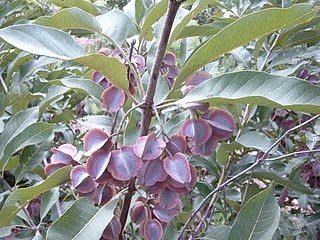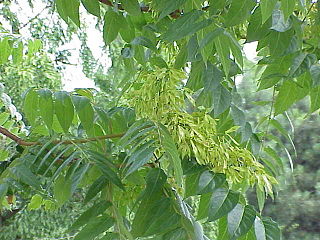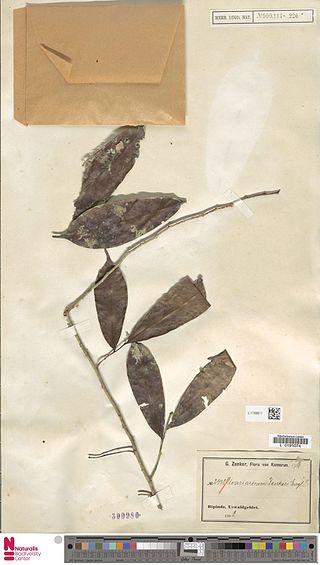Sunni Islam is the largest branch of Islam, followed by 85–90% of the world's Muslims. Its name comes from the word Sunnah, referring to the tradition of Muhammad. The differences between Sunni and Shia Muslims arose from a disagreement over the succession to Muhammad and subsequently acquired broader political significance, as well as theological and juridical dimensions. According to Sunni traditions, Muhammad left no successor and the participants of the Saqifah event appointed Abu Bakr as the next-in-line. This contrasts with the Shia view, which holds that Muhammad appointed his son-in-law and cousin Ali ibn Abi Talib as his successor.

Combretum, the bushwillows or combretums, make up the type genus of the family Combretaceae. The genus comprises about 272 species of trees and shrubs, most of which are native to tropical and southern Africa, about 5 to Madagascar, but there are others that are native to tropical Asia, New Guinea and the Bismarck Archipelago, Australia, and tropical America. Though somewhat reminiscent of willows (Salix) in their habitus, they are not particularly close relatives of these.

Boutique hotels are small-inventory, design-driven hotels, often located in shopping centers. Positioning is secondary for these hotels as they focus on authenticity and personalization. They capitalize on the desire for rich experiences by incorporating elements such as nature and environment, cuisine, history, local culture and community, service and wellness.

The Simaroubaceae are a small, mostly tropical, family in the order Sapindales. In recent decades, it has been subject to much taxonomic debate, with several small families being split off. A molecular phylogeny of the family was published in 2007, greatly clarifying relationships within the family. Together with chemical characteristics such as the occurrence of petroselinic acid in Picrasma, in contrast to other members of the family such as Ailanthus, this indicates the existence of a subgroup in the family with Picrasma, Holacantha, and Castela.

Schinopsis is a genus of South American trees in the family Anacardiaceae, also known by the common names quebracho, quebracho colorado and red quebracho. In Brazil it is known as baraúna or braúna.
Social criticism is a form of academic or journalistic criticism focusing on social issues in contemporary society, in particular with respect to perceived injustices and power relations in general.

The genus of the myrrhs, Commiphora, is the most species-rich genus of flowering plants in the frankincense and myrrh family, Burseraceae. The genus contains approximately 190 species of shrubs and trees, which are distributed throughout the (sub-) tropical regions of Africa, the western Indian Ocean islands, the Arabian Peninsula, India, and South America. The genus is drought-tolerant and common throughout the xerophytic scrub, seasonally dry tropical forests, and woodlands of these regions.
Isolona is a genus of flowering plants in the family Annonaceae. There are 21 species native to Africa. They occur in humid habitat types.

Uvariastrum is a genus of plant in family Annonaceae.

Xylopia is a genus of flowering plants in the family Annonaceae. They are mostly trees and some shrubs. There are about 160 species distributed in Asia, Africa, and the Americas.

Aroideae is a subfamily of flowering plants in the family Araceae. It is the largest subfamily in Araceae and consists of about 72 different genera, and 2,300 species. Many Aroideae have spiny pollen grains without a sporopollenin outer exine layer and lacking an aperture.

Artabotrys is a genus of plants in the Annonaceae family. There are over 100 species in the Old World tropics, with 31 species in Africa. It is part of the custard apple family (Annonaceae). All species are small trees or shrubs with a tendency to climb. Leaves are simple and alternate, without hairs. Bisexual flowers are borne singly or in clusters opposite the leaves. The 6-petalled flowers are scented, and the plant bears fleshy fruits.

Cola is a genus of trees native to the tropical forests of Africa, classified in the family Malvaceae, subfamily Sterculioideae. Species in this genus are sometimes referred to as kola tree or kola nut for the caffeine-containing fruit produced by the trees that is often used as a flavoring ingredient in beverages. The genus was thought to be closely related to the South American genus Theobroma, or cocoa, but the latter is now placed in a different subfamily. They are evergreen trees, growing up to 20 m tall, with glossy ovoid leaves up to 30 cm long and star-shaped fruit.

Rhaphiostylis beninensis is a woody, sprawling or scrambling glabrous, evergreen shrub or liane native to Tropical Africa, belonging to the family Metteniusaceae, and one of 3 species in the genus Rhaphiostylis. It is traditionally used as an anti-inflammatory by the Bantu people of Africa.

Annonoideae is a subfamily of plants in the family Annonaceae, with genera distributed in tropical areas world-wide. The family and this subfamily are based on the type genus Annona.
Iodes is a genus of flowering plants belonging to the family Icacinaceae.











